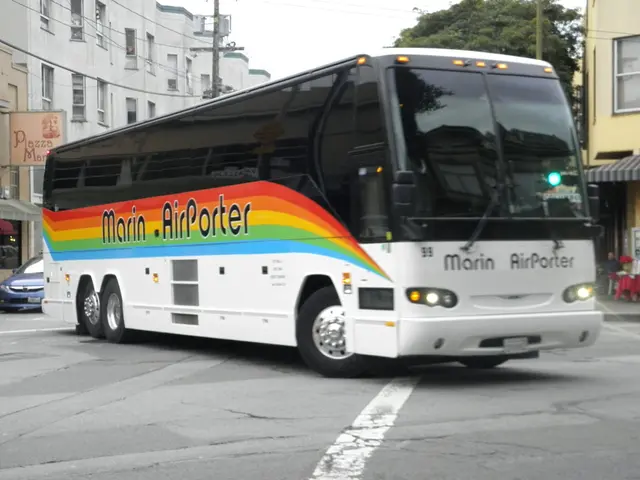Awards for Scientific and Technical Advancements in the Movie Industry Announced by the Academy of Motion Picture Arts and Sciences (AMPAS) at the Oscars
The 2025 Academy Scientific and Technical Awards Honor Pioneering Film Technologies
The Academy of Motion Picture Arts and Sciences has announced the recipients of the 2025 Scientific and Technical Awards, honouring nine groundbreaking advancements in filmmaking technology represented by 25 award recipients.
This year's awards encompass a wide range of film production advancements, including fire stunt safety, stabilized hand-held camera operation, animation, post-production innovations in dialogue capture, and CG imagery rendering systems.
Machine Learning Denoisers
Technical Achievement Awards were given to developers of several ML-based denoising tools that enhance CGI images by fixing imperfections and reducing noise. Notably:
- Wētā FX's ML Denoiser by Javor Kalojanov and Kimball Thurston, used in films like Better Man and A Minecraft Movie.
- Disney's ML Denoiser created by Thijs Vogels, Fabrice Rousselle, David Adler, Gerhard Röthlin, and Mark Meyer.
- Intel Open Image Denoise by Attila T. Áfra.
- NVIDIA’s application of U-Nets to denoising by Timo Aila.
These advancements in machine learning denoising have been instrumental in streamlining production and pushing artistic boundaries.
Transportable Six-Degrees-of-Freedom Motion Base Technology
Mark Noel received recognition for contributions to the NACMO series of transportable motion bases that enhance motion simulation for cinematic experiences.
Pose Space Deformation (PSD)
Invented by J.P. Lewis, Matt Cordner, and Nickson Fong, Pose Space Deformation introduced new sparse data interpolation methods to improve shape interpolation, enabling more controllable and artistically driven character animations.
Other Notable Achievements
- Essex Edwards, James Jacobs, Jernej Barbic, Crawford Doran, and Andrew van Straten received an Academy Award for the design and development of Ziva VFX, a system for constructing and simulating muscles, fat, fascia, and skin for digital characters.
- Dustin Brooks and Colin Decker developed naked burn gel, first publicly demonstrating a "naked burn," where fire appears directly on the skin, enabling a new form of safe fire stunts in motion pictures.
- Curt Schaller received an Academy Award for the concept, design, and development of the Trinity 2 system, a body-worn system that combines a traditional inertial camera stabilization system with electronic gimbal technology, allowing unprecedented freedom of camera movement for acquiring shots with multiple transitions that are otherwise unobtainable.
The 14 scientific and technical achievements will be honoured at the Academy's annual Scientific and Technical Awards ceremony on April 29, 2025, at the Academy Museum of Motion Pictures. The Academy's CEO Bill Kramer and President Janet Yang stated that the recipients' work has significantly driven advancements in the film industry.
These innovations represent advances in computer graphics, animation, artificial intelligence (specifically machine learning), and simulation technology, all of which contribute significantly to the quality and creativity in motion pictures.
References: [1] Academy of Motion Picture Arts and Sciences [2] Variety
- The Academy of Motion Picture Arts and Sciences honored contributors to machine learning denoising tools, such as Wētā FX's ML Denoiser, Disney's ML Denoiser, Intel Open Image Denoise, and NVIDIA’s U-Net application, which have been instrumental in improving CGI images and artistic boundaries in filmmaking.
- Mark Noel was recognized for his contributions to the NACMO series of transportable motion bases, which enhance cinematic experiences by providing advanced motion simulation.
- Pose Space Deformation (PSD), invented by J.P. Lewis, Matt Cordner, and Nickson Fong, introduced new sparse data interpolation methods that improve character animations, offering more control and artistic flexibility.
- Essex Edwards, James Jacobs, Jernej Barbic, Crawford Doran, and Andrew van Straten were awarded for designing and developing Ziva VFX, a system for simulating muscles, fat, fascia, and skin for digital characters.
- Dustin Brooks and Colin Decker created naked burn gel, allowing for a new form of safe fire stunts in motion pictures with a direct appearance of fire on the skin.
- Curt Schaller's Trinity 2 system, combining a traditional inertial camera stabilization system with electronic gimbal technology, received an Academy Award for offering unprecedented camera movement and multiple transitions.
- This year's Scientific and Technical Awards ceremony, held at the Academy Museum of Motion Pictures on April 29, 2025, celebrated 14 groundbreaking achievements in computer graphics, animation, artificial intelligence, and simulation technology, significantly driving advancements in the film industry.




